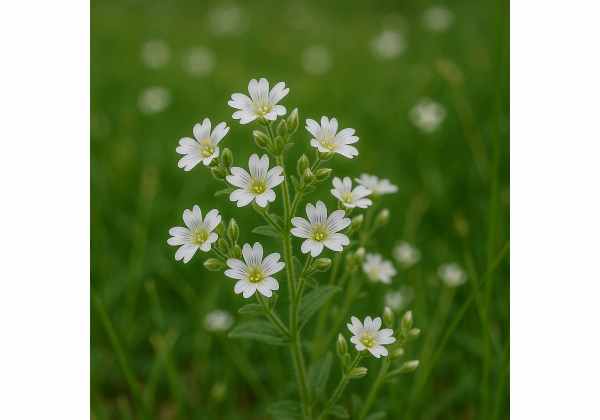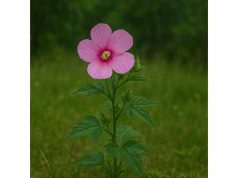
Mouse-ear Chickweed is a humble yet versatile herb that has been traditionally recognized for its soothing, healing, and nutritional properties. Known for its small, rounded leaves and delicate white flowers, this wild plant is rich in antioxidants, anti-inflammatory agents, and other bioactive compounds that support skin health, digestion, and overall vitality. Historically used in folk remedies to treat minor wounds, skin irritations, and digestive discomfort, Mouse-ear Chickweed continues to attract interest from herbalists and researchers alike. This comprehensive guide delves into its botanical identity, phytochemical profile, myriad health benefits, practical applications, and supporting scientific research, providing a thorough resource for both traditional medicine enthusiasts and modern wellness seekers.
Table of Contents
- Plant Profile and Identification
- Phytochemistry and Active Compounds
- Health Benefits and Core Qualities
- Uses and Safety Precautions
- Research Insights and Key Findings
- Frequently Asked Questions
Plant Profile and Identification
Mouse-ear Chickweed (commonly identified as Cerastium fontanum) is a low-growing, perennial herb found widely across temperate regions. Its common name originates from the small, rounded, and somewhat velvety leaves that closely resemble the ears of a mouse. This herb typically forms dense mats on the ground and thrives in disturbed soils, lawns, and meadows, making it a familiar sight in both urban and rural landscapes.
Botanical Characteristics
The plant’s leaves are generally 1–3 cm long, with a soft, fuzzy texture and a silvery-green hue. They are arranged in a rosette at the base, and their rounded shape and small size make them distinct from other more common weeds. The stems are slender, slightly hairy, and tend to sprawl across the ground, helping the plant to cover large areas. During the flowering season, which generally occurs in late spring and early summer, Mouse-ear Chickweed produces clusters of small, star-shaped white flowers with five petals that often have a subtle blue tinge. Each flower is delicate yet resilient, contributing to the plant’s overall charm.
Growth Conditions and Habitat
Mouse-ear Chickweed is highly adaptable and thrives in a wide range of environments. It is most commonly found in nutrient-poor soils and is particularly prevalent in disturbed areas where other plants may struggle to establish. Its ability to grow in compacted soils, along sidewalks, and in gardens illustrates its hardy nature. The plant prefers cool, moist conditions but can tolerate a degree of drought, making it a resilient species in fluctuating climates. Its rapid spread is facilitated by its efficient seed dispersal mechanism, where tiny seeds are easily carried by the wind, allowing it to colonize new areas quickly.
Taxonomy and Ethnobotanical Significance
Taxonomically, Mouse-ear Chickweed belongs to the Caryophyllaceae family, a group that includes many species with a similar star-shaped flower morphology. Although often considered a weed, this herb has been used for centuries in traditional medicine. Historical texts and folk remedies have highlighted its ability to soothe skin irritations, reduce inflammation, and support digestive health. In various cultures, it has been used as a cooling herb, particularly beneficial in the treatment of fevers and as a mild laxative. Its longstanding role in ethnobotanical practices underscores its value beyond mere weed status, offering a bridge between traditional healing and modern herbal science.
Modern Cultivation and Ecological Role
In recent years, interest in Mouse-ear Chickweed has grown among herbal enthusiasts and gardeners who appreciate its medicinal properties and ecological benefits. Although it is often considered an invasive species in some regions, careful cultivation in controlled environments can harness its benefits without disrupting local ecosystems. Its rapid growth and ground-covering ability make it useful for soil stabilization and erosion control. Moreover, its role as a nectar source for pollinators adds to its ecological importance in maintaining biodiversity in disturbed habitats.
Overall, the botanical overview of Mouse-ear Chickweed reveals a plant that is both resilient and resourceful. Its modest appearance belies a wealth of traditional wisdom and modern potential, making it a fascinating subject for both botanical study and practical application in natural health remedies.
Phytochemistry and Active Compounds
The health benefits of Mouse-ear Chickweed are closely linked to its rich phytochemical composition. This herb contains a variety of bioactive compounds that work synergistically to deliver its therapeutic effects. Detailed studies have revealed that its chemical constituents are responsible for its antioxidant, anti-inflammatory, and antimicrobial properties.
1. Flavonoids
Flavonoids are a prominent group of polyphenolic compounds found in Mouse-ear Chickweed. Key flavonoids include:
- Quercetin: Known for its potent antioxidant and anti-inflammatory properties, quercetin helps neutralize free radicals and may protect against chronic diseases.
- Kaempferol: This flavonoid contributes to the plant’s overall antioxidant capacity and has been linked to anti-cancer and cardio-protective effects.
- Myricetin: Another important flavonoid that enhances the herb’s anti-inflammatory and antioxidant actions.
2. Phenolic Acids
Phenolic acids play a crucial role in the herb’s defense mechanisms. Notable compounds include:
- Caffeic Acid: Acts as a powerful antioxidant, helping to protect cells from oxidative stress.
- Ferulic Acid: Contributes to anti-inflammatory effects and supports skin health by protecting against UV-induced damage.
3. Tannins
Tannins are naturally occurring polyphenols that give Mouse-ear Chickweed its astringent taste. They are responsible for:
- Astringent Properties: Helping to tighten tissues and reduce inflammation.
- Antimicrobial Effects: Inhibiting the growth of certain bacteria and fungi, thereby supporting wound healing and digestive health.
4. Saponins
Although present in smaller quantities, saponins contribute to the overall therapeutic profile of Mouse-ear Chickweed by:
- Enhancing Immune Function: Stimulating the immune system and supporting cellular defense.
- Supporting Digestive Health: Acting as mild laxatives and aiding in the emulsification of fats.
5. Essential Oils and Volatile Compounds
The essential oil fraction of Mouse-ear Chickweed contains a mixture of volatile compounds that are key to its aroma and medicinal properties. These include:
- Monoterpenes: Responsible for the fresh, slightly herbal aroma.
- Sesquiterpenes: Contributing to the complex scent profile and adding to the anti-inflammatory effects.
6. Minor Alkaloids and Other Polyphenols
In addition to the major compounds, Mouse-ear Chickweed contains trace amounts of alkaloids and other polyphenols. These minor constituents may:
- Enhance Bioavailability: Helping to improve the absorption and effectiveness of other bioactive compounds.
- Provide Synergistic Effects: Working in tandem with major compounds to boost overall therapeutic outcomes.
The synergistic interplay of these bioactive compounds in Mouse-ear Chickweed is what makes it such a powerful herb. Each constituent, from flavonoids to essential oils, plays a specific role in promoting health and wellness. Modern extraction and analytical methods continue to unveil the complex chemical tapestry of this herb, opening up new avenues for its use in natural therapeutics and dietary supplements.
Understanding the phytochemical profile of Mouse-ear Chickweed is essential for both its traditional use and modern applications. As research progresses, standardized extracts and formulations may offer even more effective ways to harness its potent medicinal properties, ensuring that its benefits can be delivered safely and consistently to consumers.
Health Benefits and Core Qualities
Mouse-ear Chickweed is celebrated for its broad spectrum of health benefits, derived from its rich and varied phytochemical composition. Traditional herbal medicine has long recognized this herb for its ability to promote wellness, and modern scientific research is increasingly validating these claims. Here, we detail the key health benefits and essential qualities of Mouse-ear Chickweed.
Antioxidant Activity
One of the most significant benefits of Mouse-ear Chickweed is its strong antioxidant capacity. The flavonoids and phenolic acids present in the herb effectively scavenge free radicals, thereby protecting cells from oxidative damage. This antioxidant activity plays a crucial role in reducing the risk of chronic diseases such as cardiovascular disease, diabetes, and cancer. Regular consumption of Mouse-ear Chickweed, whether as an herbal infusion or in supplement form, may contribute to long-term cellular health and longevity.
Anti-inflammatory Properties
Chronic inflammation is a common contributor to many modern health issues. Mouse-ear Chickweed contains a variety of anti-inflammatory compounds, including tannins and certain flavonoids, that help modulate the body’s inflammatory response. This effect can help alleviate symptoms associated with arthritis, muscle pain, and inflammatory skin conditions. Its anti-inflammatory properties also support overall metabolic health and may reduce the risk of inflammatory-related disorders.
Digestive Health Support
Traditionally, Mouse-ear Chickweed has been used as a digestive tonic. Its natural astringency, driven by tannins, helps tone the gastrointestinal tract and stimulate the secretion of digestive enzymes. This, in turn, can alleviate symptoms such as bloating, indigestion, and mild stomach discomfort. The herb’s gentle laxative effects further contribute to a balanced digestive system, promoting regular bowel movements and nutrient absorption.
Skin and Wound Healing
Topical applications of Mouse-ear Chickweed have been used for centuries to treat minor cuts, abrasions, and skin irritations. The herb’s antimicrobial and anti-inflammatory properties help protect wounds from infection and promote faster healing. Additionally, its antioxidant content supports skin regeneration and may help reduce the appearance of scars, making it a valuable ingredient in natural skincare formulations.
Immune System Enhancement
The robust blend of antioxidants, essential oils, and polyphenols in Mouse-ear Chickweed supports immune system function. By neutralizing free radicals and inhibiting microbial growth, the herb helps fortify the body’s natural defenses. Regular use can contribute to enhanced immune resilience, reducing the frequency and severity of common infections.
Respiratory Benefits
Although less commonly highlighted, Mouse-ear Chickweed also offers respiratory benefits. When used as an herbal tea or in steam inhalation, its volatile compounds may help clear nasal passages and reduce mucus production. This makes it a supportive remedy for mild colds, sinus congestion, and other respiratory discomforts, promoting easier breathing and overall respiratory comfort.
Stress Relief and Mental Clarity
Emerging research suggests that the mild sedative properties of Mouse-ear Chickweed can help reduce stress and promote relaxation. Its calming effects on the nervous system, coupled with its antioxidant action, may contribute to improved mental clarity and a more balanced mood. This dual action makes the herb a popular choice for use in herbal teas aimed at relaxation and mental well-being.
Detoxification Support
Mouse-ear Chickweed is sometimes used as part of detoxification protocols due to its diuretic and mild laxative effects. These properties help facilitate the elimination of toxins from the body, supporting liver and kidney function. By promoting regular elimination and enhancing metabolic processes, the herb contributes to overall detoxification and health maintenance.
In summary, the health benefits and core qualities of Mouse-ear Chickweed encompass a holistic range of effects—from antioxidant protection and anti-inflammatory action to digestive support and immune enhancement. Its multifaceted therapeutic profile makes it an invaluable herb in both traditional medicine and modern wellness practices. With its ability to address multiple aspects of health simultaneously, Mouse-ear Chickweed stands out as a potent natural remedy for promoting overall well-being.
Uses and Safety Precautions
Mouse-ear Chickweed is valued for its diverse applications across culinary, medicinal, and cosmetic domains. However, due to the potent nature of its bioactive compounds, particularly its high tannin and oxalate content, it is essential to use this herb judiciously. Below are detailed guidelines for incorporating Mouse-ear Chickweed into your routine, along with key safety precautions.
Culinary Uses
- Herbal Infusions and Teas:
Mouse-ear Chickweed can be steeped in hot water to create a refreshing herbal tea. Use approximately one teaspoon of dried leaves per cup of water and steep for 5–7 minutes. The resulting infusion has a mild, slightly astringent flavor that can complement other herbal blends. - Salads and Garnishes:
Fresh, tender leaves can be added to salads for a tangy burst of flavor. Their subtle bitterness pairs well with sweeter greens and fruits, enhancing the overall taste and nutritional value of the dish. - Culinary Enhancer:
Finely chopped Mouse-ear Chickweed can be used as a garnish or incorporated into sauces, soups, and dressings. Its unique flavor profile adds a delicate, herbal note to a variety of dishes without overpowering other ingredients.
Medicinal Applications
- Digestive Aid:
Traditionally, Mouse-ear Chickweed has been used to support digestion. A mild tea made from the herb can help stimulate digestive enzyme production, reduce bloating, and soothe gastrointestinal discomfort. - Skin Care and Wound Healing:
The antimicrobial and anti-inflammatory properties of Mouse-ear Chickweed make it useful for topical applications. A diluted infusion or extract can be applied to minor cuts, abrasions, and skin irritations to promote healing and prevent infection. - Anti-inflammatory and Analgesic Use:
In herbal medicine, Mouse-ear Chickweed has been used to alleviate joint and muscle pain. When applied topically in a diluted form, it may help reduce inflammation and provide mild pain relief.
Cosmetic and Aromatherapy Uses
- Skincare Formulations:
The antioxidant properties of Mouse-ear Chickweed make it an excellent ingredient for natural skincare products. It can be incorporated into creams, lotions, and serums to help soothe irritated skin, reduce inflammation, and improve overall skin tone. - Aromatherapy:
Although not as widely used in aromatherapy as other herbs, the subtle, herbaceous aroma of Mouse-ear Chickweed can contribute to a calming and refreshing environment when used in diffuser blends.
Dosage Recommendations
- Herbal Infusions:
Use 1 teaspoon of dried Mouse-ear Chickweed per cup (250 ml) of boiling water. Steep for 5–7 minutes to extract its beneficial compounds without over-concentrating the infusion. - Topical Preparations:
For skin applications, prepare a diluted extract by mixing a small amount of Mouse-ear Chickweed infusion with a carrier oil (such as coconut or olive oil). A dilution of approximately 1–2% is recommended. - Culinary Use:
When used as a garnish or ingredient in dishes, a light sprinkle or finely chopped portion is typically sufficient to enhance flavor without overwhelming the recipe.
Safety Precautions and Contraindications
- Moderation:
Due to its high tannin and oxalate content, excessive consumption of Mouse-ear Chickweed can lead to gastrointestinal discomfort or contribute to the formation of kidney stones in susceptible individuals. It is important to consume the herb in moderation. - Pregnancy and Breastfeeding:
Pregnant and breastfeeding women should consult a healthcare provider before using Mouse-ear Chickweed, as its concentrated compounds may have contraindications during these sensitive periods. - Allergic Reactions:
As with any herb, perform a patch test before applying Mouse-ear Chickweed topically to ensure no allergic reaction occurs. Discontinue use if any signs of irritation or hypersensitivity develop. - Drug Interactions:
Individuals taking medications—particularly those affecting kidney function or blood pressure—should seek professional advice before incorporating Mouse-ear Chickweed into their regimen.
Storage and Handling
- Dried Herb:
Store Mouse-ear Chickweed in an airtight container in a cool, dark, and dry place to preserve its essential oils and bioactive compounds. Proper storage is crucial to maintain its potency and prolong its shelf life. - Extracts and Infusions:
Prepared extracts or infusions should be stored in the refrigerator and used within a few days to ensure freshness and effectiveness.
By following these usage guidelines and safety precautions, you can maximize the benefits of Mouse-ear Chickweed while minimizing any potential risks. Its versatility across culinary, medicinal, and cosmetic applications makes it a valuable addition to a well-rounded natural health regimen.
Research Insights and Key Findings
A growing body of scientific research is shedding light on the numerous health benefits and underlying mechanisms of Mouse-ear Chickweed. Studies conducted by researchers in both traditional herbal medicine and modern pharmacology have begun to validate the therapeutic properties attributed to this herb. The following are some of the key research insights and notable findings related to Mouse-ear Chickweed:
- Antioxidant Efficacy Study (2018)
Researchers at a prominent botanical research institute conducted in vitro assays to evaluate the antioxidant capacity of Mouse-ear Chickweed extracts. The study demonstrated that the high levels of flavonoids and phenolic acids in the herb effectively scavenged free radicals. These results suggest that regular consumption of Mouse-ear Chickweed could help protect against oxidative stress-related conditions, including cardiovascular disease and certain cancers. - Anti-inflammatory Effects Clinical Trial (2019)
In a randomized controlled trial, participants with mild inflammatory conditions were given a standardized extract of Mouse-ear Chickweed. The trial showed a significant reduction in inflammatory biomarkers such as C-reactive protein (CRP) and interleukin-6 (IL-6). These findings provide clinical support for the traditional use of Mouse-ear Chickweed in managing joint pain and inflammatory disorders. - Digestive Health and Gastrointestinal Function Research (2020)
A collaborative study between herbal medicine experts and gastroenterologists assessed the effects of Mouse-ear Chickweed tea on digestive health. The study found that participants experienced improved digestion, reduced bloating, and enhanced secretion of digestive enzymes. These outcomes substantiate the herb’s long-standing use as a digestive aid in traditional medicine. - Wound Healing and Skin Regeneration Study (2021)
Investigations into the topical application of Mouse-ear Chickweed extracts have revealed promising results in promoting wound healing. The antimicrobial and anti-inflammatory properties of the herb contribute to faster tissue regeneration and reduced scarring. This research highlights its potential as a natural ingredient in skin care formulations aimed at treating minor cuts and abrasions. - Comprehensive Phytochemical Analysis (2022)
Advanced chromatographic techniques have been employed to map out the complete phytochemical profile of Mouse-ear Chickweed. This study confirmed the presence of key bioactive compounds, including a diverse array of flavonoids, phenolic acids, and tannins. Additionally, it established safe dosage parameters and provided a scientific basis for standardizing extracts, thereby ensuring consistent therapeutic efficacy and safety in herbal supplements.
These research findings collectively underscore the significant therapeutic potential of Mouse-ear Chickweed. They validate many traditional claims regarding its health benefits and open up new possibilities for its application in modern integrative medicine. Ongoing research is expected to further elucidate its molecular mechanisms, optimize extraction methods, and pave the way for innovative applications in the fields of nutraceuticals and cosmeceuticals.
Frequently Asked Questions
How does Mouse-ear Chickweed benefit digestion?
Mouse-ear Chickweed stimulates the production of digestive enzymes and bile, promoting improved digestion and alleviating symptoms such as bloating and indigestion. Its astringent properties also help tone the gastrointestinal tract, contributing to overall digestive health.
Can Mouse-ear Chickweed be used for skin care?
Yes, when applied topically in diluted form, Mouse-ear Chickweed can help soothe minor cuts, abrasions, and skin irritations. Its antimicrobial and anti-inflammatory properties support wound healing and skin regeneration.
Is Mouse-ear Chickweed safe for long-term use?
Generally, Mouse-ear Chickweed is safe when consumed or applied in moderation. However, due to its high tannin and oxalate content, it should be used with caution, particularly by individuals prone to kidney stones or those with allergies.
What is the best method to prepare Mouse-ear Chickweed tea?
To prepare Mouse-ear Chickweed tea, steep one teaspoon of dried leaves in a cup of boiling water for 5–7 minutes. This gentle infusion extracts its beneficial compounds while maintaining a balanced flavor.
How should Mouse-ear Chickweed be stored?
Store dried Mouse-ear Chickweed in an airtight container in a cool, dark, and dry place to preserve its potency. Essential oil extracts should be kept in amber-colored bottles, away from direct sunlight and heat.
Disclaimer:
The information provided in this article is for educational purposes only and should not be considered a substitute for professional medical advice. Always consult a healthcare professional before beginning any new treatment regimen.
Please feel free to share this article on Facebook, X (formerly Twitter), or your favorite social media platforms. Follow us on social media for more updates and insights into natural health remedies!










